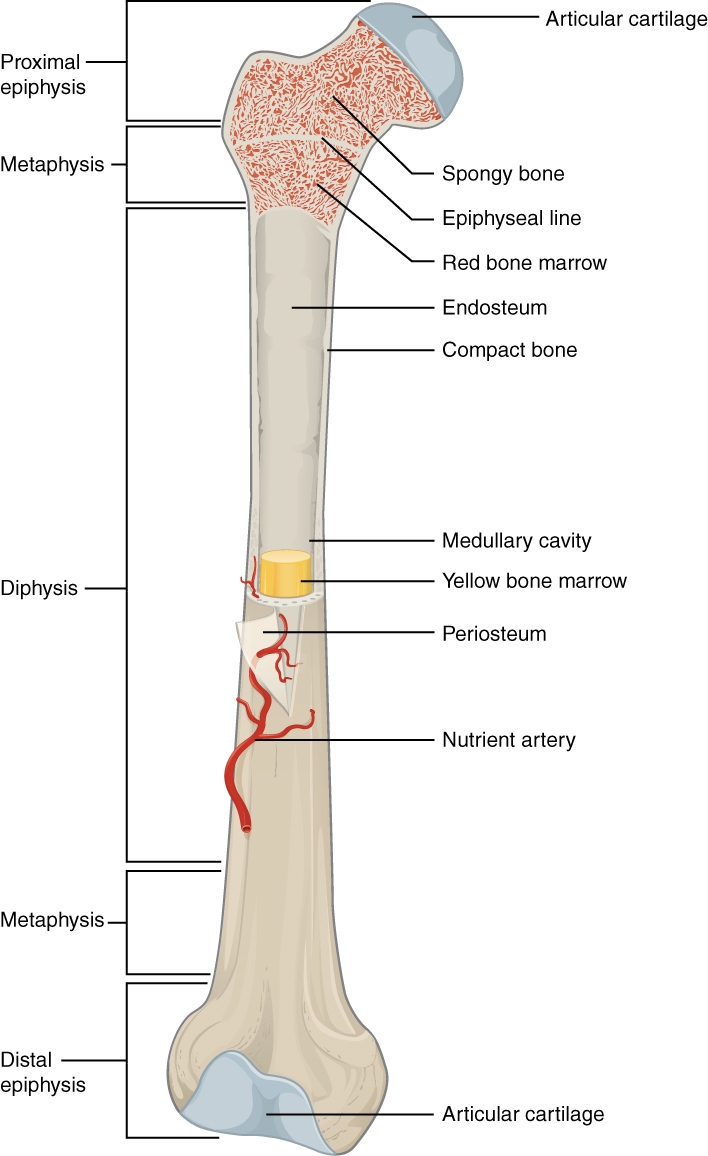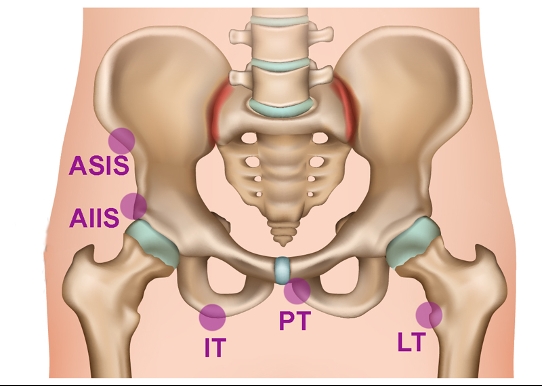Pulling your leg: Hip avulsion injury is no joke

An avulsion injury occurs when large or chronic forces transmitted through muscles, tendons, and connective tissue pull a fragment of bone away at the site of its insertion. The local anatomy and skeletal maturity contribute to the propensity to suffer from avulsion injuries. Younger athletes are at much higher risk of avulsion from muscles that insert at the epiphyseal line, also known as the physis or growth plate, which is the weakest part of the immature skeleton (see figure 1).
Occurrence and etiology of hip avulsion injuries
Avulsion injuries commonly occur at the hip and pelvis because the body’s largest and most powerful muscles attach here(1). Avulsion fractures in the hip region are more commonplace in adolescent athletes whose bones are still growing. Though these fractures can occur in older adults, the myotendinous junction usually gives way to excessive forces before the mature ossified bone does(2). When these do happen in older athletes, they typically involve an underlying pathological process(3).While the weakest area of bone in the immature skeleton is the physis, avulsions also occur where tendons insert into an apophysis, or outcropping of bone(4,5). Younger athletes remain vulnerable to avulsion fractures until the apophyses fully fuses with the bone, around 25 years old(6,7).
Figure 1: Skeletal anatomy*

*OpenStax College, CC BY 3.0 <creativecommons.org/licenses/by/3.0>, via Wikimedia Commons
Injury location
The location of an avulsion injury varies according to the demands of the sport played (see table 1)(8). However, there is considerable overlap between sports. The majority of hip avulsion fractures in athletes occur during the eccentric phase of movement because eccentric contractions generate significantly higher forces than concentric ones(9). Most avulsion fractures are a result of trauma or explosive effort; however, chronic and slowly evolving injuries also result from repetitive stress on the attachment site(1).A Canadian review examined the data collated from 66 incidences of avulsion fracture to determine the association between the physical/sporting activity and age at injury(10). It found that 88% of the cases occurred during physical activity. The other 12% of athletes reported a history of a surgery in the area. Tellingly, the average age in the cases resulting from sport was 16.8 years, while it was 56 years in the surgery-related cases. Of the cases involving sporting activity, the most commonly reported mechanisms were kicking (19.7%) and running (40.9%) (see table 2). This data supports previous research identifying athletes who play soccer and running sports as having the highest incidence of avulsion fractures(4,11). Although most hip avulsion injuries are acute, athletes who play soccer, tennis, or run are susceptible to chronic overload(12).
| Location (decreasing order of frequency) | Muscle insertion | Most frequent sports activities |
|---|---|---|
| Ischial tuberosity | Hamstrings | Gymnastics, soccer, fencing, tennis, running |
| Anterior inferior iliac spine | Rectus femoris | Soccer, athletics, tennis |
| Anterior superior iliac spine | Sartorius | Soccer, athletics, gymnastics |
| Superior corner of pubic symphysis | Rectus abdominis | Soccer, fencing |
| Iliac crest | Abdominal muscles | Soccer, gymnastics, tennis |
| Lesser trochanter | Iliopsoas | Athletics |
| Site/Mechanism | Running | Kicking | Extreme ROM | Jumping | Surgery related | Other | Total | % |
|---|---|---|---|---|---|---|---|---|
| ASIS | 6 | 2 | 1 | 0 | 7 | 3 | 19 | 28.8 |
| AIIS | 4 | 8 | 0 | 1 | 0 | 0 | 13 | 19.7 |
| PC | 0 | 0 | 1 | 0 | 0 | 0 | 1 | 1.5 |
| AC | 0 | 0 | 1 | 0 | 0 | 0 | 1 | 1.5 |
| IC | 7 | 1 | 0 | 0 | 2 | 10 | 15.2 | |
| IT | 10 | 2 | 4 | 1 | 1 | 4 | 22 | 33.3 |
| Total | 27 | 13 | 7 | 2 | 8 | 9 | 66 | |
| % | 40.9 | 19.7 | 10.6 | 3 | 12.1 | 13.6 | 100 |
Presentation and diagnosis of hip avulsion injury
*Acute injury - In acute avulsion injuries, the typical presentation is often identical to that of a muscle strain. In these cases, clinicians should consider the possibility of an acute avulsion injury as part of their differential diagnosis, especially if the athlete is young (under 25) or has had previous surgery in the affected area. Even a minimal trauma or mild strain, such as tripping or rising from a seated position, can result in an avulsion injury in bone with weakness due to surgery(10). Athletes often report the trauma as a result of a powerful physical movement, such taking off on a sprint. They may describe a popping sensation, followed by sudden or shooting pain, weakness, swelling, and difficulty walking(4).*Chronic injury - Repetitive overuse can also lead to chronic avulsion or insertional injuries in some adolescent athletes. These injuries occur more insidiously over time, with localized pain. However, there is no clear history of a precipitating trauma, and unlike acute injuries, there may not be swelling and tenderness. Typical locations for chronic avulsion injuries include the proximal attachment of the gracilis and adductor muscles at the symphysis pubis and the inferior pubic ramus – also known as rectus‐adductor syndrome or adductor insertion avulsion syndrome(13).
Location-specific diagnosis
Due to the complex musculotendinous anatomy in the hip region, an avulsion injury’s symptoms can vary greatly depending on its location (see figure 1)(1). Clinicians can use these variations in location-specific presentations, along with imaging studies, to provide a correct diagnosis.- Avulsion of the anterior superior iliac spine - Avulsion injury at the anterior superior iliac spine (ASIS) is relatively common, accounting for around 28 % of all pelvic avulsion injuries(14). Sprinters or jumpers are at particular risk for this type of avulsion injury due to forceful hip extension. Patients present with pain upon palpation just below the ASIS. The avulsed fragment is typically displaced distally and laterally, leading to an erroneous diagnosis of an avulsion injury to the anterior inferior iliac spine (AIIS). However, a detailed clinical history and exam, along with diagnostic radiographs, are usually sufficient for diagnosis.
- Avulsion of the anterior inferior iliac spine - Avulsion injuries of the AIIS are almost always a consequence of forceful hip extension. This movement pattern occurs when sprinting, jumping, or kicking, as while playing soccer. Like the ASIS, AIIS avulsion injuries are also relatively common, accounting for around 20–25% of all pelvic avulsion injuries(15). Athletes with injuries here typically present with anterior hip/groin pain and tenderness on palpation directly over the superior aspect of the hip joint. Clinicians can reproduce the pain with active hip flexion against resistance or during hip flexion and knee extension.
- Avulsion of the ischial tuberosity – The ischial tuberosity is another common site for pelvic avulsions (4). It is the insertion point for the long head of the biceps femoris, the semitendinosus, and the semimembranosus muscle. Young athletes such as soccer players, runners, and dancers are vulnerable to this injury during powerful hip flexion with knee extension or sudden and excessive passive lengthening(16). Athletes with this injury will typically present with a sudden pain in the buttocks or proximal dorsal thigh, which may also prevent ambulation. The pain is usually more pronounced during sitting compared to standing. Although the history and trauma mechanism - in conjunction with clinical signs, such as localized swelling, pain, and difficulty walking - are somewhat characteristic, practitioners often misdiagnose this avulsion injury.
- Avulsion injuries at the pubic ramus and symphysis pubis – These avulsion injuries involve the adductor longus, adductor brevis, and the pectineus. Avulsion injury from the adductor muscles typically results from chronic overuse and repetitive microtrauma, and rarely due to a sudden forceful contraction against resistance. These injuries are more likely to occur in sports such as soccer, ice hockey, and tennis. Athletes complain of groin pain, which is unilateral and relatively nonspecific. Athletic pubalgia is the term for this pain in its chronic form. The differential diagnosis of pain in this area should include osteitis pubis, sportsman’s hernia, or an acetabular labral tear.
- Avulsion of the lesser trochanter – This is a rare injury in young athletes, comprising around 1–3% of all avulsion injuries occurring in the hip region(17). The lesser trochanter is the site of the insertion of the iliopsoas muscles. Competitive track and field athletes may experience a forceful and abrupt contraction of this muscle, resulting in an avulsion fracture. This injury typically presents with considerable pain and limited function, relieved by hip flexion. Upon examination, the medial thigh is tender on palpation, and active flexion against resistance is impossible. A suspected avulsion fracture at the lesser trochanter in adults can signify a pathologic condition, such as metastatic cancer(18).
Figure 1: typical sites of pelvic avulsion injuries in anterior view

NB - AIIS: anterior inferior iliac spine, ASIS: anterior superior iliac spine, IT: ischial tuberosity, LT: lesser trochanter, PT: pubic tubercle.
Part II of this article will examine the best imaging modalities for hip avulsion injuries and explain the most up to date injury management guidelines.
References
- Fortschr Röntgenstr 2020; 192: 431–440
- Br J Sports Med. 2007 Nov; 41(11): 827–831
- AJR Am J Roentgenol. 2002 Feb; 178(2):423-7
- Skeletal Radiol. 2001 Mar; 30(3):127-31
- Br J Sports Med. 2006 Sep; 40(9):749-60
- Skeletal Radiol. 1996 Jan; 25(1):3-11
- Sports Med. 1998 Aug; 26(2):119-32
- Radiol Clin North Am. 2001 Jul; 39(4):773-90
- Br J Sports Med. 1977 Jun; 11(2):65-71
- J Can Chiropr Assoc. 2011 Dec; 55(4): 247–255
- Am Fam Physician. 2001 Oct 15; 64(8):1405-14
- AJR Am J Roentgenol. 1981 Sep; 137(3):581-4
- JBR-BTR. 2000 Feb; 83(1):31
- BMC Musculoskelet Disord 2017; 18: 162
- Orthopade 2016; 45: 213–218
- Int J Sports Med 1997; 18: 149–155
- Pediatr Orthop B 1993; 2: 188–190
- J Orthop Case Rep 2017; 7: 16–19
You need to be logged in to continue reading.
Please register for limited access or take a 30-day risk-free trial of Sports Injury Bulletin to experience the full benefits of a subscription. TAKE A RISK-FREE TRIAL
TAKE A RISK-FREE TRIAL
Newsletter Sign Up
Subscriber Testimonials
Dr. Alexandra Fandetti-Robin, Back & Body Chiropractic
Elspeth Cowell MSCh DpodM SRCh HCPC reg
William Hunter, Nuffield Health
Newsletter Sign Up
Coaches Testimonials
Dr. Alexandra Fandetti-Robin, Back & Body Chiropractic
Elspeth Cowell MSCh DpodM SRCh HCPC reg
William Hunter, Nuffield Health
Be at the leading edge of sports injury management
Our international team of qualified experts (see above) spend hours poring over scores of technical journals and medical papers that even the most interested professionals don't have time to read.
For 17 years, we've helped hard-working physiotherapists and sports professionals like you, overwhelmed by the vast amount of new research, bring science to their treatment. Sports Injury Bulletin is the ideal resource for practitioners too busy to cull through all the monthly journals to find meaningful and applicable studies.
*includes 3 coaching manuals
Get Inspired
All the latest techniques and approaches
Sports Injury Bulletin brings together a worldwide panel of experts – including physiotherapists, doctors, researchers and sports scientists. Together we deliver everything you need to help your clients avoid – or recover as quickly as possible from – injuries.
We strip away the scientific jargon and deliver you easy-to-follow training exercises, nutrition tips, psychological strategies and recovery programmes and exercises in plain English.










